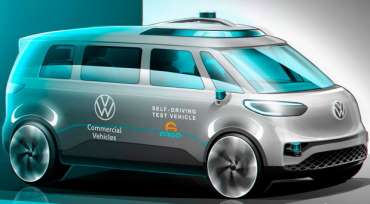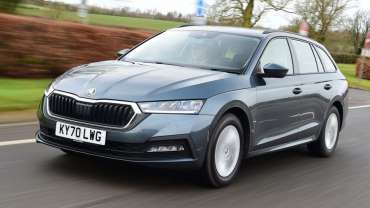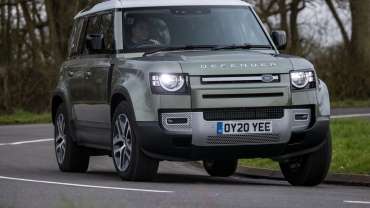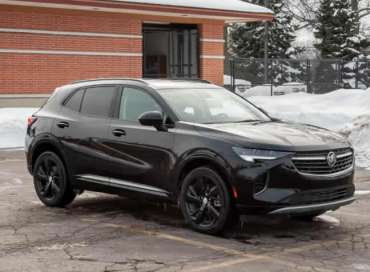
Worldcarblog.com
Autonomous Volkswagen ID.Buzz announced
Volkswagen Commercial Vehicles has also officially confirmed that it will also offer an autonomous version of the future electric model ID. Buzz.
The German manufacturer has not announced many details so far, and among other things, it was announced that this vehicle will appear in 2025 and that it will have the technology developed by Argo AI.
A drawing of the vehicle was also published, which reveals LIDAR sensors on the roof, front bumper and sides.
The car will primarily be used to transport passengers in urban areas, while more details are yet to come.
As for the standard ID. Buzz model, its promotion is expected during 2022.
New Skoda Octavia e-TEC 2021 review
The mild-hybrid Skoda Octavia e-TEC offers a cheaper way to electrification
Verdict
The Octavia e-TEC is a fine first effort at mild-hybrid propulsion from Skoda. It drives smoothly, while the ride, refinement and practicality make a strong supporting case to the impressive efficiency on offer given the price. In SE Tech trim the Octavia Estate e-TEC is a versatile and affordable choice for those looking to explore what electrification can offer.
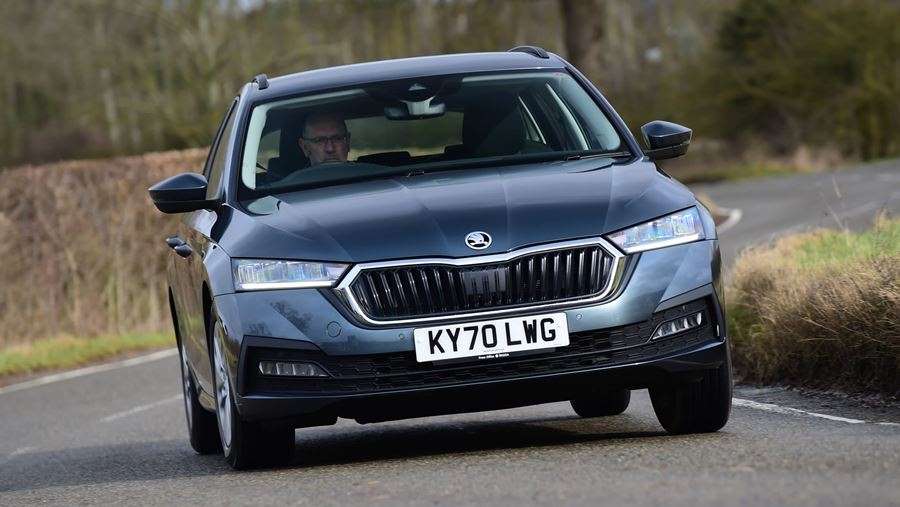
If you’re dead against diesel and still find the price of a plug-in hybrid hard to swallow, then mild-hybrid tech can be a more affordable way into an impressively efficient model – and the Skoda Octavia 1.0 TSI e-TEC proves this fact resolutely.
The e-TEC tag highlights that the Octavia, tested here in Estate form, is powered by a 1.0-litre three-cylinder turbocharged petrol engine with a belt-driven starter-generator as part of the car’s 48-volt electrical system.
It charges a small 0.6kWh lithium-ion battery when slowing down or lifting off the throttle, allowing engine-off coasting, which it’s surprisingly keen to do. It can also provide a boost of torque (up to 50Nm) to help performance when pulling away.
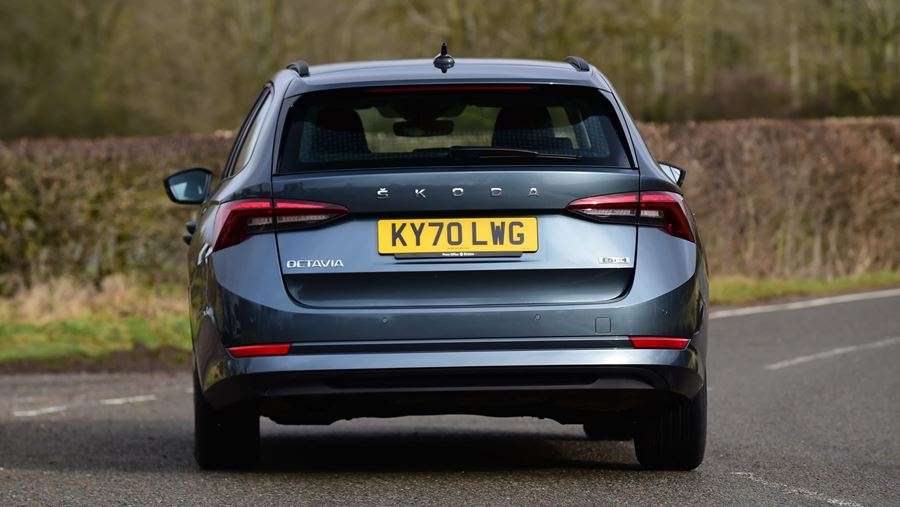
You simply don’t notice it working though, such is the system’s impressive calibration. Given that this is Skoda’s first mild-hybrid model, it’s a great effort. Total output is 108bhp and 200Nm of torque, enough for a 0-62mph time of 10.6 seconds. But that’s not important. It never feels quick, but it also never feels slow or particularly underpowered, despite the Estate’s weight.
Performance is adequate because the combustion engine’s torque is delivered low down, helped by the turbo’s variable-vane geometry, plus the small electric boost.
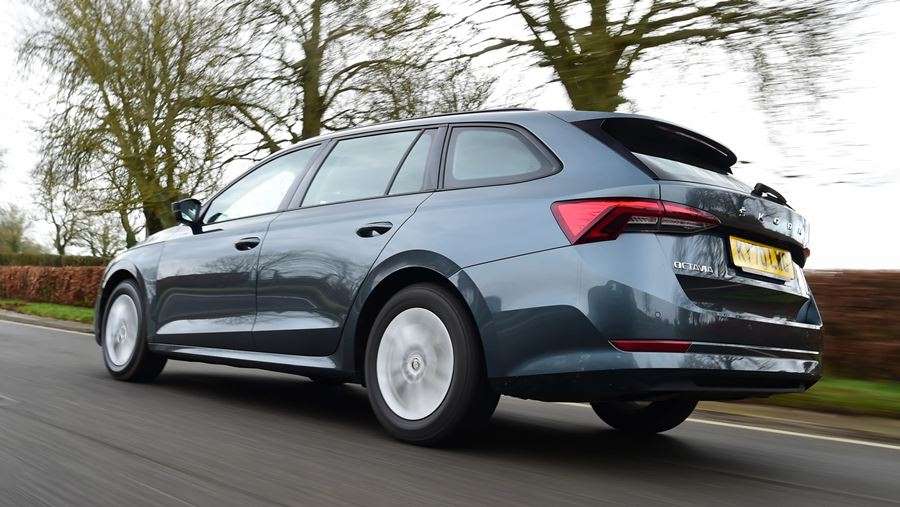
Refinement is excellent because the three-cylinder unit is so quiet under light loads when cruising that you rarely notice the engine cutting out. The needle on the digital rev counter falling to zero is the main hint.
Touch the throttle and the petrol engine fires back up quickly and smoothly (a benefit of the mild-hybrid technology and its starter-generator system), while the DSG dual-clutch gearbox handles changes with similar finesse, even if it is a little jerkier at low speed, losing some drivability compared with the best automatics.
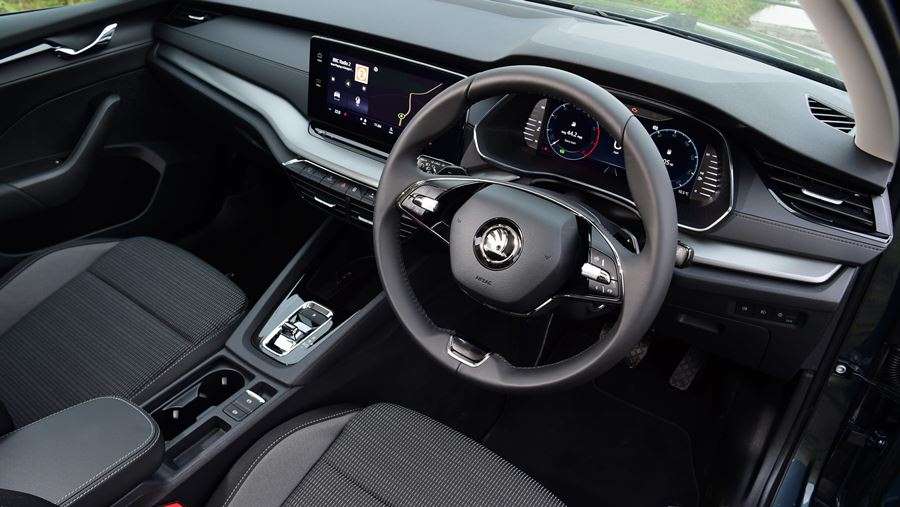
The beauty of this set-up is claimed efficiency of 54.3mpg and CO2 emissions as low as 118g/km, yet in fleet-focused SE Technology trim the newcomer costs from just £24,505 – that’s £7,680 less than an Octavia Estate iV plug-in hybrid in the same specification.
You get the same level of equipment, but due to the need to package the iV’s bigger battery there’s 150 litres more room in the e-TEC’s boot (its battery is located under the front passenger seat), at a total of 640 litres. This has long been an Octavia Estate strong point, and it’s no different here, with a simply cavernous load bay that opens out to 1,700 litres, while a pair of levers in the boot means you can flip the seat backs down at the touch of a button.
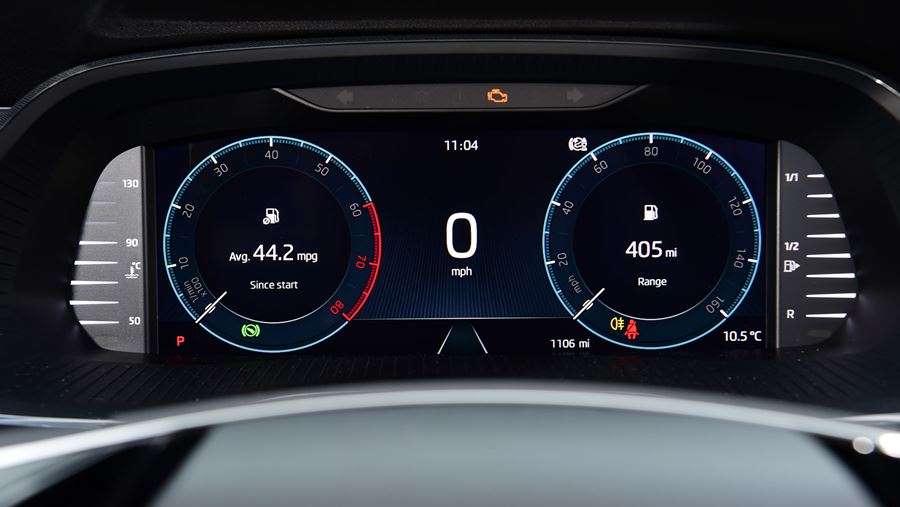
SE Technology is a solid blend of kit and cost, with LED headlights, Skoda’s Front Assist system with collision warning and autonomous braking, a 10-inch touchscreen infotainment set-up with sat-nav, Android Auto and wireless Apple CarPlay, a 10.25-inch digital dash panel, all-round parking sensors, dual-zone climate control, and 16-inch alloy wheels all fitted as standard.
Those rims help deliver a nice level of comfort and the Estate rides with composure but plenty of compliance. Combined with the quiet powertrain, it’s a very refined car.
It’s a bit bland and boring inside, despite the new fourth-generation Octavia’s smarter cabin design, while the lack of personality isn’t helped by our car’s metallic grey paint, but then this is a pragmatic choice and it fulfils that brief completely.
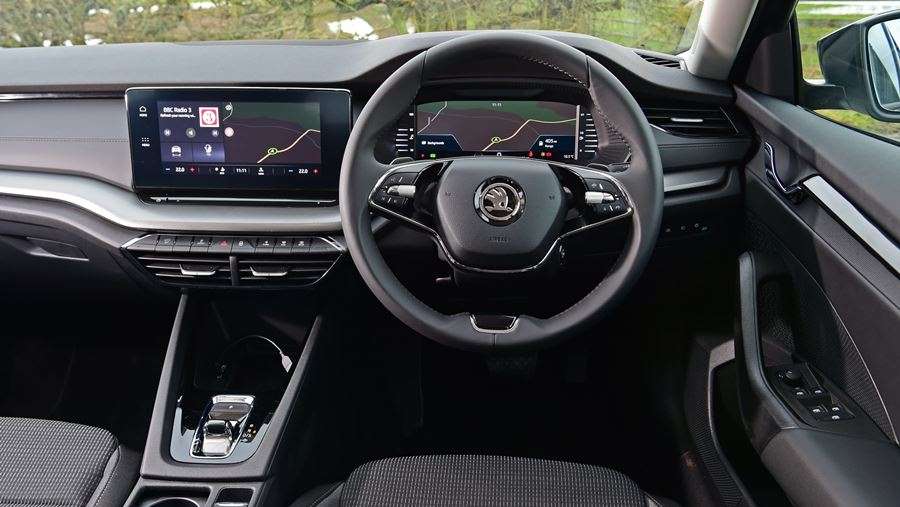
Remember that while it’s more affordable, despite the ‘hybrid’ tag associated with the e-TEC name, as a mild-hybrid it can’t run solely on electric power; its battery isn’t big enough for that and the belt starter-generator isn’t strong enough to support it. It means that if you’re after a heavily electrified model to lower your running costs (especially if you mostly travel short distances that could be covered on electricity alone) then the Octavia iV will be a better choice, with fuel efficiency claims of up to 282.5mpg and CO2 emissions as low as 23g/km.
As with any PHEV, take these figures with a pinch of salt, because if you don’t plug in at every opportunity when the battery is depleted, you’ll be carrying around that extra weight but not reaping the benefit.
If as a result your circumstances still don’t work with a plug-in though, this mild-hybrid model is yet another great Skoda.
| Model: | Skoda Octavia Estate 1.0 TSI e-TEC DSG SE Technology |
| Price: | £24,505 |
| Engine: | 1.0-litre 3cyl mild-hybrid petrol |
| Power/torque: | 108bhp/200Nm |
| Transmission: | Seven-speed dual-clutch automatic, front-wheel drive |
| 0-62mph: | 10.6 seconds |
| Top speed: | 124mph |
| Economy/CO2: | 54.3mpg/118g/km |
| On sale | Now |
5 tips that anyone can apply to become a better driver
When it comes to driving, even the most experienced among us sometimes relax, lose concentration and do things that should by no means be done while driving. Talking on a cell phone, enjoying food while driving, or looking for a CD in the glove compartment can cost you the best time to repair a bent sheet metal, but the consequences can be much worse. But still, today we will not talk about it, today we will return to the basics of driving that many of us have forgotten, and by returning to those basics we have come to five ways by which each of us can become a better driver.
1. Always think in a way that everyone around you is incompetent idiots
Okay, maybe they’re not, maybe they’re basically quite good drivers, but regardless, until you’re convinced otherwise, think of them as careless idiots who have no idea about driving. This will help you to always be vigilant, drive in a more defensive style and anticipate some of the situations that could happen in the next moments. Even when passing a crossroads at a green light, always watch out for a potential “kamikaze” that could go through a red light, as well as sudden lane changes when driving on the highway. Strange as it may sound, this is perhaps the best advice on how to become a better driver.
2. Open your eyes
Be aware of the surroundings, cyclists, other vehicles around you or children playing along the road at all times. It is not only important to follow what is happening in front of you, but also the vehicles coming from your side or from behind. Don’t focus only on the vehicle in front of you, because traffic also takes place in front of it, and by observing the situations happening in front of you, you can prepare in advance for certain dangers. In addition, it is important to always follow the signs and warnings, which can sometimes be difficult for inexperienced drivers to comply with, but with time and a sufficient number of kilometers "in the legs", these things will become the most natural thing.
3. Always keep sufficient distance between vehicles
If you notice a potential danger in front of you, stop in time, which will leave you more time and space to stop safely, but also give the vehicles behind you enough time and space to stop safely. While driving, it is important to maintain a sufficient distance between your vehicle and the vehicle in front at all times, and it is important to keep in mind that as road conditions worsen, the safety distance between vehicles should be increased.
4. Exercise in "controlled" conditions
The worst thing is that driving schools do not prepare us for many situations that could befall us on the road, but that does not mean that you cannot prepare for some of them yourself. The snow-covered parking lot is an ideal place to learn slippery driving techniques and ways to regain control of an out-of-control vehicle. In addition, such learning is also quite fun, but watch out for curbs, light poles and cars whose owners have come to have fun in a slightly different way. Another option is to attend a safe driving school, but you will have to set aside a certain amount of money for that.
5. Never drive tired
If you ever notice that you are starting to get tired, we recommend that you immediately step aside and rest, because it is always better to be late than to get off the road somewhere. The problem is that tired drivers find it difficult to concentrate on driving, they follow the environment less, and the reaction times themselves are significantly extended. An additional problem is that many in these situations are even more in a hurry to reach their desired destination, so the consequences of flying out are often very severe.
Land Rover Defender SUV review
"The Land Rover Defender has returned with an incredible repertoire of talents, including a strong range of plug-in hybrid, petrol and diesel engines"
This is the all-new Land Rover Defender, the long-awaited, much-hyped replacement for Britain's most famous SUV. It returns some four years after production of its predecessor stopped, and manages to be both similar and yet significantly different.
Its design clearly pays tribute to the original ‘Landie’, albeit in original new ways, and Land Rover still claims it's the best off-roader you can walk into a showroom and buy. However, its advanced technology, improved performance, luxury and safety kit mean the Defender has been parachuted into the 21st Century.
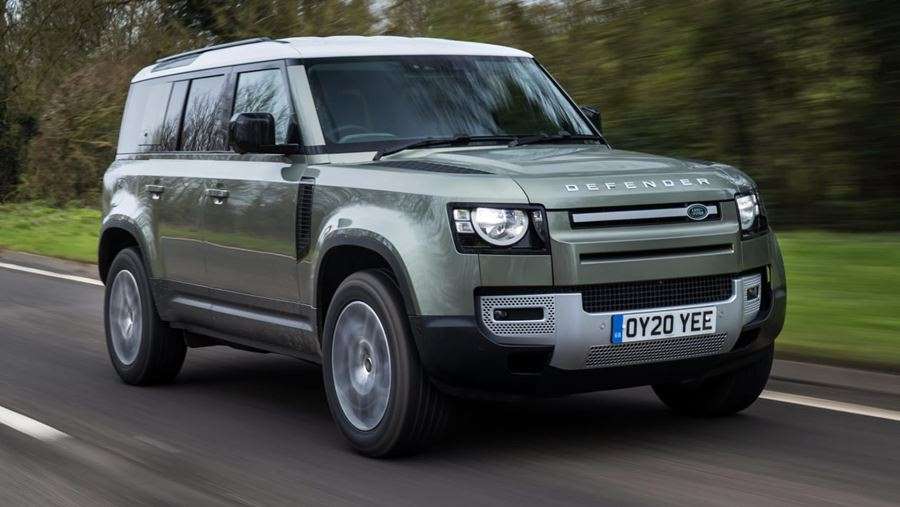
We'll let you decide whether its design is a success, but it certainly looks appropriately chunky, and details like its front and rear lights are impressively intricate. There are plenty of personalisation options too. It may be that you love the basic Defender with steel wheels, but hate the range-topper with gargantuan alloys, or vice versa. Similarly you may prefer the looks of the three-door Defender 90 or longer five-door 110, and there’s an even lengthier 130 also in the pipeline.
Inside, the Defender has a rugged, industrial aesthetic, characterised by exposed bolt heads, metal surfaces and an exposed magnesium crossmember that forms part of the car’s structure. It's also unique thanks to an optional jump seat between the front occupants that can make the 90 or 110 a six-seater. A third row of seats is also available for the 110.
Passengers are treated to the latest in-car entertainment and connectivity, with Land Rover's Pivi Pro system using two modems to ensure it can be wirelessly updated, even while being used for media, navigation or traffic updates.
At launch, a pair of four-cylinder 2.0-litre diesel engines with 197 or 237bhp were available, badged D200 and D240 respectively. These have now been replaced by a pair of 3.0-litre six-cylinder engines with mild-hybrid electrical assistance. In base D200 trim, this engine produces 197bhp, which increases to 247bhp in mid-range D250 spec and 296bhp in the range-topping D300 version.

The entry-level P300 petrol is unchanged with a 2.0-litre four-cylinder engine producing 296bhp. For those wanting more power, a 394bhp 3.0-litre straight-six petrol P400 mild hybrid is also available in the top X trim, but a starting price of £81,000 means it probably won't be a common sight on UK roads.
A P400e plug-in hybrid was introduced as part of the 2021 revisions and is the first PHEV powertrain in the history of the Defender. This model combines a 2.0-litre four-cylinder petrol engine, an electric motor and a battery pack, and is the most powerful Defender available, producing 398bhp.
The PHEV version is the fastest Defender until Jaguar’s Special Vehicle Operations division creates a high-performance V8 model, which is expected later this year. The entry-level diesel costs from £45,000 and every version has an eight-speed automatic gearbox, low-range gears and four-wheel drive.
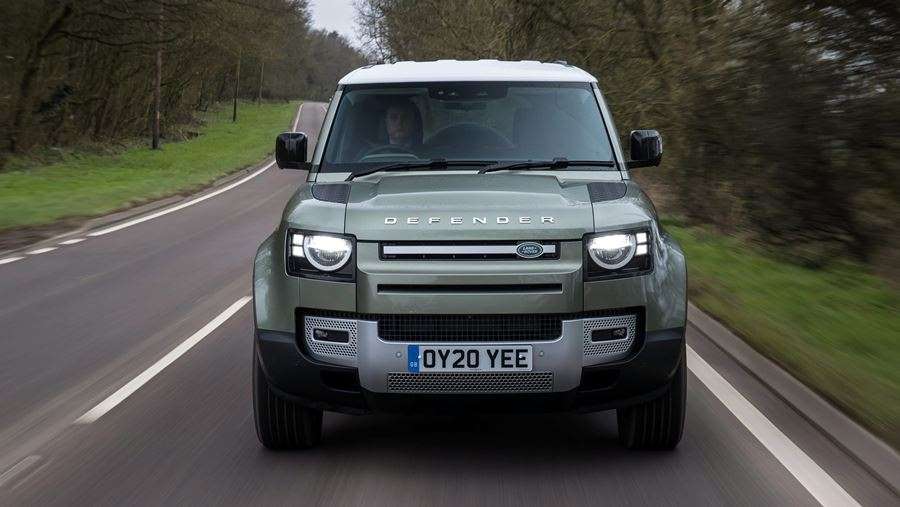
The D240 diesel is capable of getting the Defender from 0-60mph in a respectable 8.6 seconds, but it's the way the Land Rover feels to drive that's most surprising. The steering is direct and responsive, tucking the nose into corners with little hesitation and while there's some body roll, this suits the Defender's character. This is a Defender that's sporty and enjoyable to drive along a twisty road, thanks to the chameleon-like nature of its adaptive air suspension.
Off road, the same setup can extend, providing enough articulation to see the Defender crawl over almost any obstacle and wade through almost a metre of water. It's almost unstoppable off-road, and surprisingly comfortable while tackling the very roughest terrain. It can also tow up to 3,500kg and carry an unbelievable 300kg on its roof.
The Defender has always been innovative, and the latest version is one of the most intelligent cars we've ever tested. It may be rather uneconomical - at least until the plug-in arrives - but it makes up for this with impressive on and off-road manners, and an incredibly well considered design for demanding buyers, their passengers and all their gear.
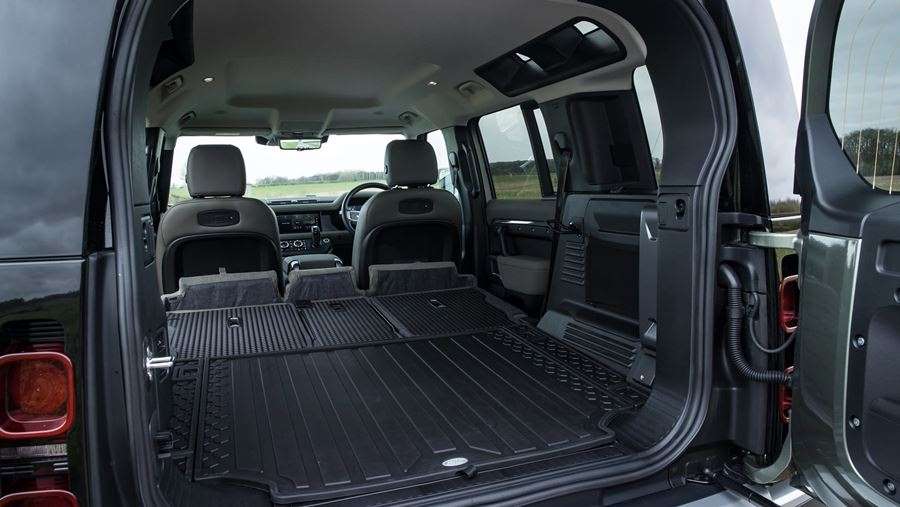
Land Rover Defender SUV - MPG, running costs & CO2
Defender buyers will be able to choose between diesel, petrol and mild-hybrid power, depending on what suits their needs and driving habits the best. Sadly, none provide especially low running costs.
Land Rover clearly prioritised performance, versatility and rugged looks over fuel-efficiency - just as they did with the original. Even the most economical version of the new Defender just manages to tip over 30mpg, while (WLTP) CO2 figures north of 230g/km mean company-car drivers will face a hefty Benefit-in-Kind bill.
Unlike the original Landie, which had the same commercial status as a van or pickup, the new standard versions of the Defender 90 and 110 are classed as private vehicles, with the van-like 90 and 110 Hard Top the only versions to be classed as commercial vehicles. A plug-in hybrid is now available, and we expect a range-topping V8 model to arrive in due course - details of the latter have yet to be confirmed.
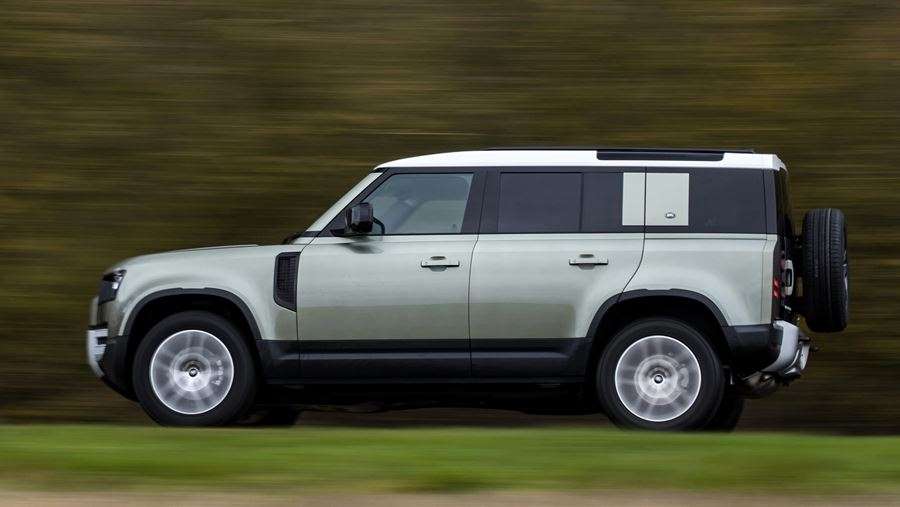
The Defender was launched with two diesel 'Ingenium' 2.0-litre turbo engines badged D200 and D240, returning up to 32.2mpg in the 90 and 31.7mpg in the Defender 110. CO2 emissions span from 230-253g/km (WLTP).
These have been replaced for 2021, with a new 3.0-litre straight-six diesel engine boasting mild-hybrid tech. The D200 version of this engine can manage around 32mpg, a figure which is closely matched by the more powerful D250 and D300 models. All three engines emit 231-233g/km of CO2.
The 2.0-litre turbo petrol P300 can manage around 24mpg with emissions of over 260g/km, the same ballpark figures as the 3.0-litre P400 mild hybrid. Thanks to its 19.2kWh battery pack, the P400e plug-in hybrid can manage up to 27 miles on electricity alone, giving it official figures of 85.3mpg and CO2 emissions of 74g/km. This should make it the cheapest Defender to run by some margin and the only one that should be on company-car shopping lists. It also just qualifies for free entry into the London Congestion Charge zone, sneaking under the current threshold by 1g/km.
The battery can be charged at home using a 7.2kW wallbox, taking it from 0-80% in two hours. It will also be possible to use a 50kW rapid-charger (using the supplied cable), for an 80% charge in 30 minutes.
Insurance groups
Insurance groups for pricey, complex SUVs tend to be a bit higher than for normal cars. That's certainly the case here, because even the entry-level D200 sits in group 31 out of 50, while the D240 First Edition sits in group 38. That's the same rating as the P300 petrol receives in SE trim, while the P400 X is in group 44.
Warranty
Land Rover provides a three-year/unlimited-mileage warranty with its new models, which matches BMW and Mercedes. It's not as generous as some brands, though; the Kia Sorento comes with a seven-year warranty as standard.
Servicing
Land Rover offers servicing plans that can help spread the cost of maintenance, so they're worth exploring with the dealership. It's also worth noting that diesel engines require AdBlue top-ups every so often.
Land Rover Defender SUV - Engines, drive & performance
The Land Rover Defender has a wider range of talents than almost any other vehicle on sale
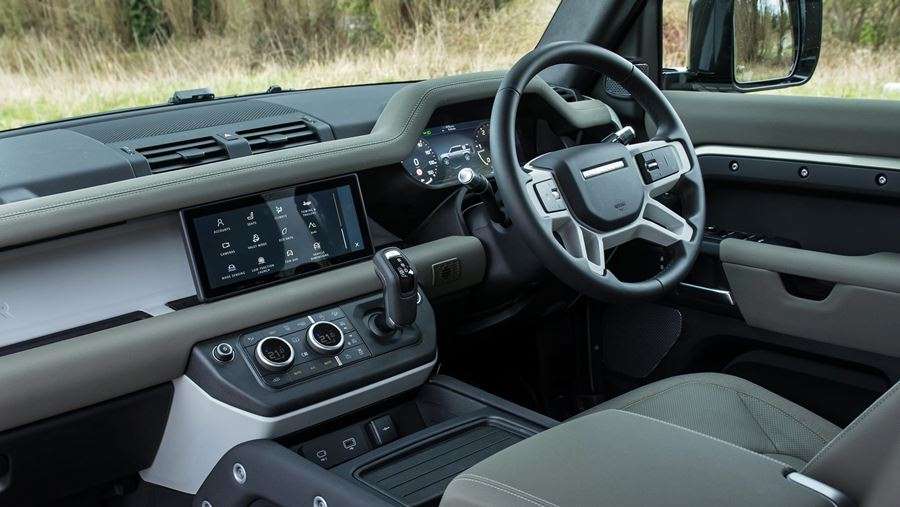
It might be one of the most loved models of all time, but one thing the Defender was never famous for was its everyday performance. Enough low-down grunt to get up steep bank and tow a trailer, yes, but not straight-line speed away from the lights.
With a more advanced powertrain, the new Defender has a far broader set of talents. Its advanced adaptive four-wheel drive and air suspension (on top trims) ensures it's still capable of traversing the world's most inhospitable terrain, but it can also tear from 0-62mph in as little as six seconds.
Just as impressive as its on-paper statistics, there's the fact it's simply fun to drive as well. Many have questioned whether the new Defender would tread on the toes of the Discovery, but from behind the wheel it instantly has a character of its own. Its steering is more alert and faster to react, while the Defender's air suspension is firmer and there's more feedback flowing back through your fingertips and the seat as you drive.
Attack a British road, and the Defender is instantly enjoyable and feels surprisingly sporty, digging its front tyres into the road. It's remarkably composed too; the fact the body leans slightly through faster corners and the nose lifts under acceleration only seems to add to its character.
Yet, the same suspension can transform to scale ruts, wade through deep water and absorb torturous bumps. Every Defender is fitted with an eight-speed automatic gearbox that also has low-range ratios designed for off-road driving and towing. At Eastnor Castle's off-road experience centre, sections have been opened up for the first time in a decade to test the Defender's extreme capabilities. A set of tortuous undulating water-filled pits is a particular challenge, and just when you think the Defender is about to get stuck, its Terrain Response 2 software modulates power to the wheels to find just enough traction to drag it out the other side.
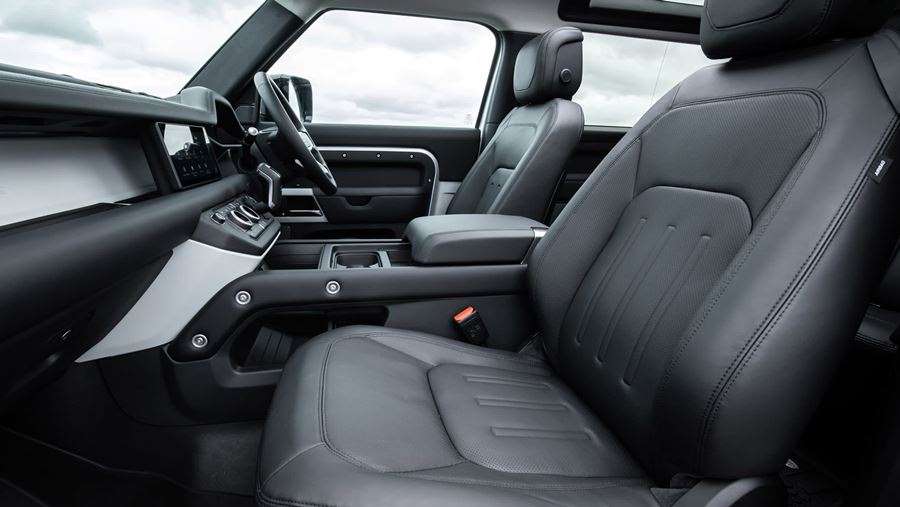
Designed around Land Rover's new D7x platform that's incredibly stiff - and has been subjected to years of rigorous testing during its development - the Defender has approach and departure angles of 38 and 40 degrees respectively, along with a 900mm wading depth. It can tackle 45-degree side slopes and inclines, and its Terrain Response 2 system can be used to adjust the chassis and differentials manually or simply be left in Auto, where it recognises the surface you're driving on.
The Defender launched with two versions of the 2.0-litre 'Ingenium' diesel engine, badged D200 and D240, with the same 430Nm of torque but 197 and 237bhp respectively. Both get an automatic gearbox and permanent four-wheel drive as standard, and cover the 0-60mph dash in 9.9 seconds and 8.7 seconds.
Early impressions are that it's the best use of the engine yet, and we especially like how Land Rover has altered its sound. This has been done by augmenting engine noise using the car's audio system, with the resulting background noise more like a rumble than a high-pitched diesel growl. A sensitive throttle pedal means the D240 engine also feels impressively responsive.
Land Rover is already replacing them with larger 3.0-litre straight-six diesel engines equipped with mild-hybrid hardware. These are badged D200 (with 197bhp), D250 serving up 247bhp and D300 with 296bhp. Acceleration from 0-62mph takes 10.2, 8.3 and 6.7 seconds respectively.
Petrol engines
Unlike the previous iteration of Defender, buyers can choose between two petrol engines, badged P300 and P400. The smaller 2.0-litre turbo gets 296bhp, propelling the car from 0-60mph in 7.6 seconds, while the 3.0-litre straight-six P400 has 395bhp and gets to 60mph in six seconds.
The P400 is also fitted with 48-volt mild-hybrid electrical assistance, designed to harvest the energy normally wasted under deceleration and store it in a small lithium-ion battery. This can be used to bolster the engine's torque under acceleration and provide stop and start more of the time when waiting in traffic.
It's the most fun version to drive, for now, with a tuneful sound from its six-cylinder petrol and impressive acceleration. Interestingly, there are no steering wheel-mounted paddles for the automatic gearbox, as engineers don't feel they fit the Defender ethos, but you can nudge the gearstick to shift manually. The engine and steeringing again feel surprisingly willing for a big, heavy SUV.
Plug-in hybrid engines
The Defender P400e plug-in hybrid uses a 2.0-litre petrol engine, electric motor and a 19.2kWh lithium-ion battery. With a combined 398bhp, it's the fastest Defender available until an anticipated performance model arrives with a V8 engine, getting from 0-62mph in 5.6 seconds. Unfortunately, the P400e is limited to the Defender 110 model. Air suspension and 20-inch alloy wheels come as standard.
Land Rover Defender SUV - Interior & comfort
Former Defender owners won't recognise the level of luxury and comfort on offer
The Defender's interior is like nothing else on the market today, combining retro nods to the original like exposed screw heads and bare metallic surfaces, along with the debut of new technology for the entire Land Rover brand.
As you'd hope, there are also innovations, such as a system that uses real-time camera feeds to offer a view of the obstacles immediately ahead without the nose of the car getting in the way. ClearSight can also be used to provide an uninterrupted rear-view mirror, even if the Defender is loaded with passengers and luggage or the rear window is caked in mud.
Fans of industrial design will adore touches like the powder-coated aluminium surfaces and magnesium bulkhead, the latter being a functional part of the Defender's body structure. It's undeniably tough-looking, and its extreme off-road capabilities are reinforced by the quantity and sturdiness of grab handles for passengers to cling onto. The flat, horizontal shapes are clearly a nod to its predecessors, as is the jutting centre console with a stubby gearlever and oversized switchgear.
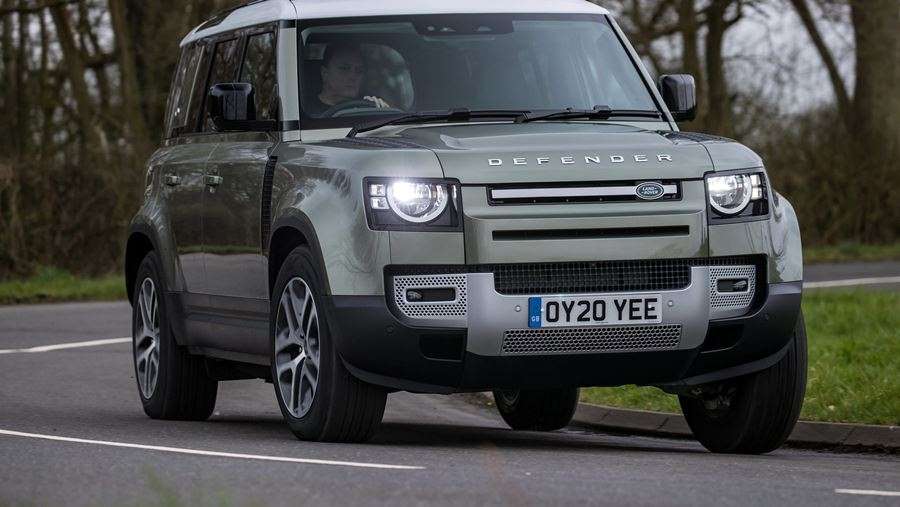
But it's not completely retro; there's a modern aesthetic not unlike the design of the latest Apple Mac Pro. The 10-inch Pivo Pro infotainment system is all new, using dual-eSIM modems that can receive over-the-air software updates and provide media and navigation without interruptions. An auxiliary battery also means it can work in the background even when the Defender is parked up, and resume more quickly. It also supports a mobile app that can be used to interact with the Defender and set the climate control remotely.
Equipment
Land Rover certainly hasn't held back when it comes to offering a wealth of trim levels and customisation options to customers. Even the trim levels are somewhat overwhelming, with Defender, S, SE, HSE, First Edition and X all offered, along with a myriad of options that even extend to what sort of roof you'd prefer.
The standard 110 model comes fitted with rather appealing 18-inch gloss white steel wheels, LED headlights, heated front seats, the 10-inch Pivi Pro system, surround cameras, cruise control and air suspension. S adds 19-inch alloy wheels, leather upholstery and digital instruments, while SE upgrades the headlights with a 'signature' look for the daytime running lights, along with keyless entry, 20-inch wheels and ISOFIX for the front passenger seat. It also adds some key features like a 10-speaker stereo, electric steering column and ClearSight rear-view mirror.
HSE increases the luxury further with a folding fabric roof (Defender 90 only, with a sliding panoramic roof for the 110), Matrix LED headlights, extended leather interior and a heated steering wheel. The range-topping X gets a black roof and bonnet, black exterior trim, orange brake calipers, front skid plate and tinted rear lights. It also has more off-road hardware, but you wouldn't know it inside thanks to Walnut veneer, heated rear seats and a 14-speaker stereo. It's also only available with the most powerful D300 and P400 engines.
Options
It's hard to know where to start with the Defender's options, but rest assured its packs and accessories cover every eventuality, from a tow bar to a ramp that makes it easier for your dog to clamber into the boot.
A good kicking off point is the curated equipment packs called Explorer, Adventure, Country and Urban. Explorer adds the famous snorkel air intake, a roof rack, waterproof side-mounted gear carriers, a matte black front badge and items like mud flaps and a cover for the spare wheel.
The Adventure pack includes an on-board pressure washer (with a 6.5-litre tank) designed for rinsing off boots and outdoor sports gear, scuff plates, mud flaps, and an integrated air compressor. There’s a similar roster of add-ons in the Country pack. In contrast, the Urban pack adds metal pedals to the interior, while rear bumper scuff plates, a spare wheel cover and front skid plate protect the exterior.
Land Rover Defender SUV - Practicality & boot space
Configured wisely, the Land Rover Defender offers serious load-lugging abilities
Like the rest of the Defender's attributes, the practicality on offer is also highly flexible and customisable. The biggest decision facing buyers will be whether to go for the five-door 110 model, or the three-door 90. An even larger Defender 130 with eight seats is also expected to arrive later on.
Land Rover Defender interior space & storage
Choose the three-door 90 and the Defender can still carry up to six people. That's thanks to a unique jump seat between the front seats, made possible by the dashboard-mounted gearlever. It's big enough for kids, and when the optional middle seat isn't in use, folding it forwards transforms it into a large central armrest and cubby. The biggest sticking point is the lack of rear doors because anyone getting in the back has to climb rather high to negotiate the front seats.
The 110 is also offered in a 5+2 layout, which is Land Rover speak for adding two smaller seats in the boot. These are best suited to kids but adults may also be able to travel for shorter hops in a pinch.
There are also handy features like USB or 12-volt power sockets for charging portable devices, a backpack that secures to the rear seat and 'click and go' system for middle-row passengers to attach tablets, bags, laptops and jackets. Then there are innovations like the side mounted 'Gear Carriers' that are 24-litre lockable and waterproof containers that mount on the Defender's rear window pillars in a similar fashion to motorcycle saddle bags.
The five-seat Defender 110 has 1,075 litres of cargo space behind the seats, expanding to a massive 2,300 litres when the seats are folded down. A rubberised floor is designed to shrug off spills and be brushed or wiped clean. The Defender 90 is notably less spacious, with a shallow 397-litre boot that's smaller than a Honda Civic's.
It's worth noting that the Defender has a traditional side-hinged tailgate, not a hatchback like most of the SUVs currently on sale. This can be fairly heavy (it also carries a full-size spare wheel) and will require some room behind the vehicle to open fully. However, it does open on the correct side for UK roads, with the opening towards the kerb, and is a characterful nod towards its predecessor.
Towing
Defenders have long been used for towing, and the latest version is seriously capable. It can pull a 3,500kg braked trailer, and the Defender itself has a maximum payload of 900kg. It can also accept a static load on its roof of up to 300kg.
The Cherokee tribe is asking Jeep to change the name of the off-road vehicle
The well-known vehicle of the American company Jeep "Cherokee", which has been produced for almost 50 years, could soon change its name, since the leader of the American Indian tribe of the same name estimated that the time had come for companies and sports teams in the USA to stop using their name.
Cherokee leader Chuck Hoskins said that he does not tolerate the use of the name "Cherokee", he said that last night he was the spokesman of the tribe for AFP.
Hoskins expressed his position through a video conference on January 29 to the parent company of Jeep, the group Stelantis.
"I think the time has come in this country for companies and sports teams to withdraw the names, images and mascots of American Indians with their products, T-shirts and teams," the Cherokee leader said in a statement published Jan. 14 in the American car magazine Car and Driver. “.
He said that he was sure that it was well-intentioned, but that he no longer does them the honor of seeing his name on a car.
The Jeep company introduced the model of the off-road vehicle "Cherokee" in 1974, after which several models followed.
"The best way to honor us is to learn more about our government, our role in this country, our history, culture, language and to have a constructive dialogue with the tribes recognized by the federal government and their culture," Chuck Hoskins said. .
Under pressure, the American football team and the basketball team from Washington recently changed their name to the American Indians, the Redskins, that is, the Indians.
Americans are facing enormous prices for used cars
The rise in prices of new vehicles has far exceeded overall inflation over the past year. In response, many buyers turned to second-hand, but demand is so powerful, that the prices of these vehicles have jumped even more than is the case with the new one.
The viral pandemic has triggered price hikes throughout the U.S. automotive sector, and for many, both new and used vehicles have become unavailable.
The average price of a new vehicle, according to data from Edmunds.com, reached a record $ 40,578 in the United States, as it jumped by six percent last year.
However, that increase is nothing compared to the prices of used vehicles: The average price of a used vehicle in the United States increased last year by almost 14 percent, 10 times higher than the inflation rate, and reached 23,000 dollars.
The main reason for the rise in prices is economically simple: too few vehicles to sell during the pandemic, and too many customers. The price increase came at a bad time for customers because many have financial difficulties, and others are looking for a car in order to avoid public transport due to the virus, which is also noticeable in Europe.

Photo: Shutterstock
Traders and analysts say that high prices could remain or grow even higher in the coming years, because the stocks of new vehicles are small, and the offer of used ones is even smaller.
The shortage began last spring when the coronary virus pandemic began. Carmakers had to close North American factories to try to stop the spread of the infection. That is why the offer of new vehicles dropped, and consequently used ones. And when demand increased late last year, less was available for both.
The shortage has increased as car rental companies and other rental companies and other wholesale car buyers, who are usually the main source of used vehicles, now sell them less. With less travel and fewer people renting cars, and companies and large buyers of vehicles do not buy new ones, and therefore do not sell used as much as before.
The jump in prices has created three classes of car buyers: the wealthy can buy new vehicles, others can only buy used ones, and a third, with low incomes or bad credit, is stuck with older, less reliable vehicles.
The auto industry is still trying to recover from the devastating consequences of the pandemic last spring, when production dropped by 3.3 million vehicles due to the closure of factories. Sales have temporarily dried up, as has the supply of used vehicles.
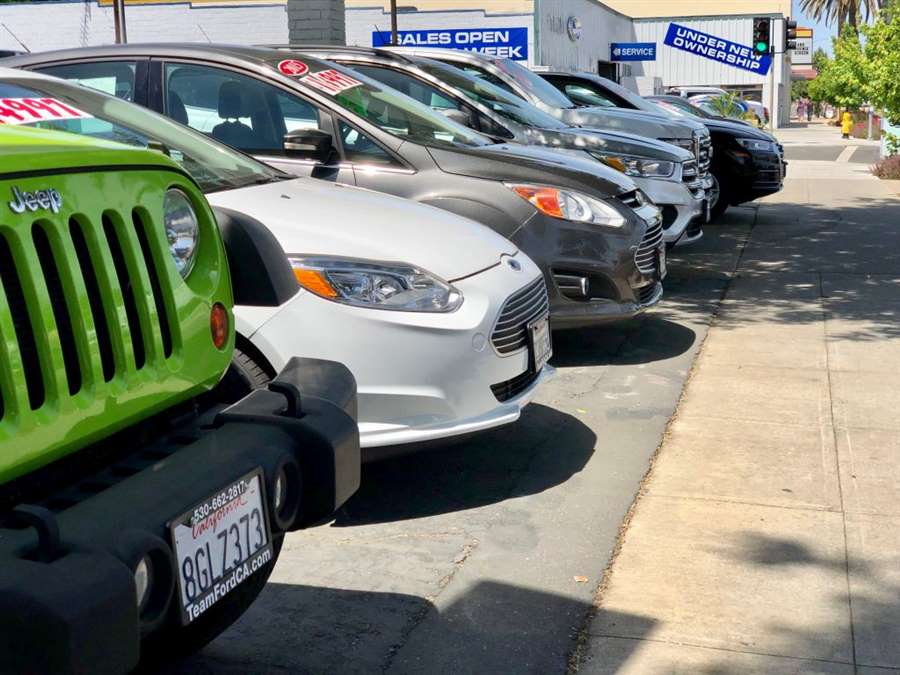
Photo: Shutterstock/ZikG
And when the factories resumed production in May, the demand became higher. The problem was that the supply of vehicles was not sufficient for demand, especially pick-ups and SUVs. Prices have risen, and the purchase of new vehicles during the year fell by almost 2.5 to a total of 14.6 million.
A good example is the case of a buyer from Michigan - in August he went to buy a new pickup and concluded that the price was excessive: more than 70,000 dollars, so he decided on a used Ford F-150 from 2019 with 29,000 miles, and that for $ 37,000, but he also paid seven-year loan insurance.
Even with loans for more than 60 months, the average monthly installment is around $ 500 for new vehicles, which is out of reach for many, but most of the demand for new cars is now more expensive than $ 50,000.
In recent years, carmakers have prepared the ground for higher prices by eliminating a multitude of models cheaper than $ 30,000 because they brought them little profit. They replaced them with SUV models whose price is significantly higher.
Since many buyers have no other options, older vehicles with more than 100,000 miles are now in high demand.
Previously, such old cars were not sold in companies, but since the quality of cars has improved sharply in the past decade, a number of companies are repairing such cars, and even providing credit assistance to customers with lower incomes or bad credit ratings.
If prices remain unaffordable, the door can be opened to a company that could make good money on cheap new cars with only basic equipment. That’s exactly what Korean carmaker Hyundai did to enter the U.S. market a few decades ago.
2021 Buick Envision Review: Premium Value
The verdict: The redesigned 2021 Buick Envision premium compact SUV is stylish and refined, and has easy-to-use tech features, but poor brake-pedal feel degrades the driving experience.
Versus the competition: Sized like a compact SUV but priced below subcompact luxury models, the 2021 Envision gives shoppers who aren’t concerned with having a traditional luxury badge a lot of value for their money.
The 2021 Buick Envision newly shares its platform with the Cadillac XT4 compact luxury SUV, and it’s wider, lower and slightly shorter than the model it replaces. Despite the redesign, it remains one of the few vehicles sold in the U.S. that’s built in China.
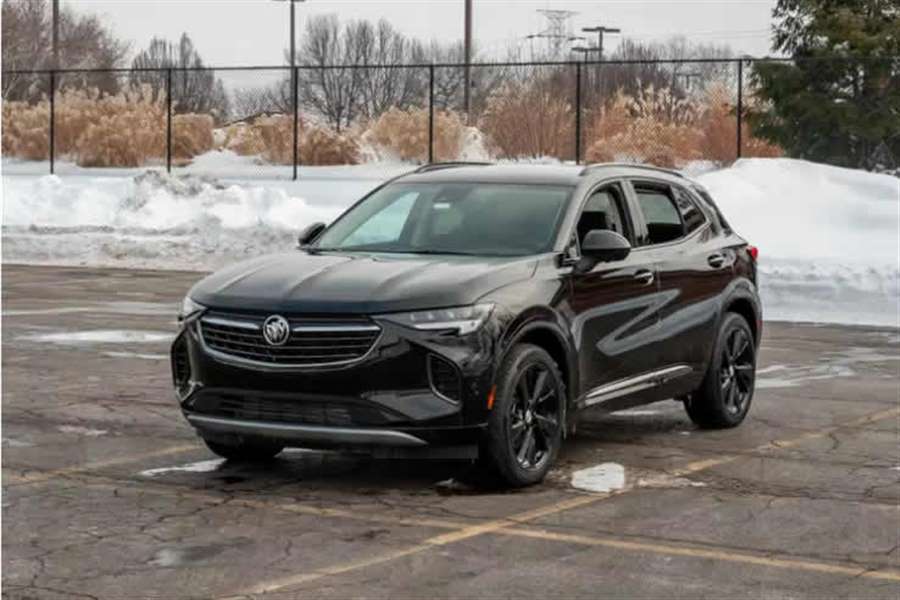
The 2021 Envision is also less expensive than its predecessor; a base Preferred trim level with front-wheel drive starts at $32,995 (including a $1,195 destination charge), which is $1,700 less than the starting price of the 2020 Envision. Our test vehicle was a mid-level Essence trim with front-wheel drive, and its as-tested price of $41,315 included a $2,500 Technology Package and a $1,325 Sport Touring Package, the latter featuring black exterior accents and 20-inch aluminum wheels. All-wheel drive is available on any trim for an extra $1,800.
How It Drives
All Envisions are powered by a 228-horsepower, turbocharged 2.0-liter four-cylinder engine that works with a standard nine-speed automatic transmission. The engine is smooth, refined and delivers adequate acceleration, and it produces a bit of a growl when you really step on the gas pedal. With nine forward gears, the automatic makes frequent upshifts when accelerating from a stop. The shifts are smooth, but there’s a short pause between gear changes. Part- and full-throttle kickdowns, however, happen without delay.
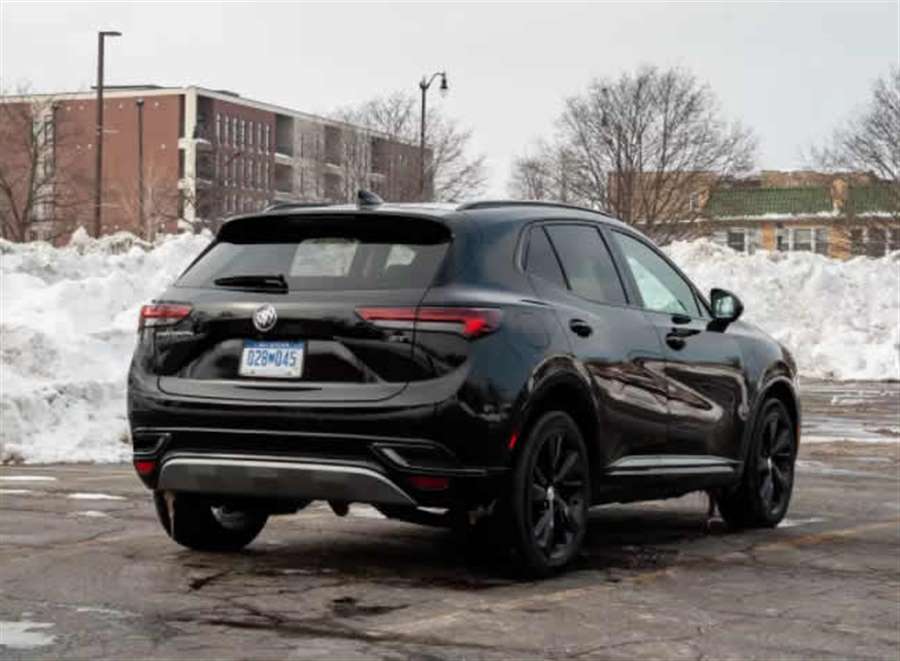
The SUV steers with a light touch, and the suspension deals swiftly with impacts from broken pavement. Body motions are well controlled overall, but the suspension tuning is on the firm side. This was especially noticeable on one stretch of road with small buckles in the asphalt, one after the other, that resulted in a choppy ride. Our test vehicle’s 20-inch wheels and low-profile tires likely didn’t help matters, and it’s possible the standard 18-inch wheels with taller-sidewall tires offer more comfort. Ditto for the top Avenir trim level’s available adaptive suspension, though experience has revealed that advanced suspensions don’t always compensate for large wheels.
The Envision’s brake-pedal feel was disappointing on a number of fronts. Pedal feel is numb, and it suffers from poor linearity on top of that. We’ve experienced this unpleasant combination in certain gas-electric hybrids, but it’s less common in conventionally powered vehicles like the Envision. Like many hybrids and a growing number of conventional vehicles, however, the Envision has a brake-by-wire system with electric assist rather than traditional vacuum-assisted power brakes. (We reported similarly disappointing braking feel in our review of the XT4, the Envision’s platform mate.)
The front-drive Envision is EPA-rated at 24/31/26 mpg city/highway/combined, while all-wheel-drive versions are rated 22/29/25 mpg. More powerful compact luxury SUVs like the Acura RDX and Lincoln Corsair get slightly worse estimated gas mileage, but the smaller BMW X1 has slightly better ratings (see fuel economy estimates for front- and all-wheel-drive versions of these SUVs).
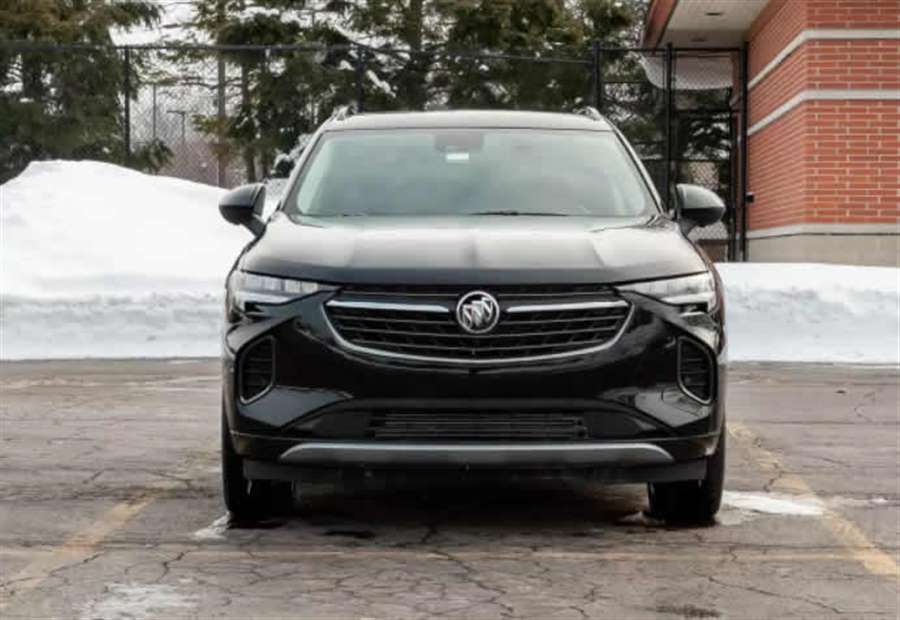
The Interior
Interior quality is good overall with soft-touch surfaces closer to eye level and hard plastic near your feet. Our test vehicle’s all-black color scheme, however, looked a bit dour to my eyes. A beige interior is also offered.
Frequently used controls are within easy reach of the driver, and the center of the dash is dominated by the optional 10.2-inch touchscreen (an 8-inch touchscreen is standard in the Preferred trim). The big screen is responsive, has an intuitive interface and looks great. There are also handy volume and tuning knobs to the left of the screen.
Both touchscreen systems include wireless Apple CarPlay and Android Auto smartphone connectivity, but only the Avenir trim includes wireless device charging. Connecting my iPhone to the multimedia system was easy, and the wireless CarPlay connection seemed just as responsive as the more common wired setup.
One of the more unique elements of the interior is the gear selector, which consists of a column of buttons and pull switches that go where a conventional shifter channel otherwise would. It didn’t take long to get accustomed to the system, but the design doesn’t result in any additional storage space on top of the front center console; there’s a small forward bin, two cupholders to the right of the shifter and a storage bin under the front center armrest. The design does, however, eliminate the obstruction a lever would represent, and its electronic nature allows for an open lower storage area below the console.
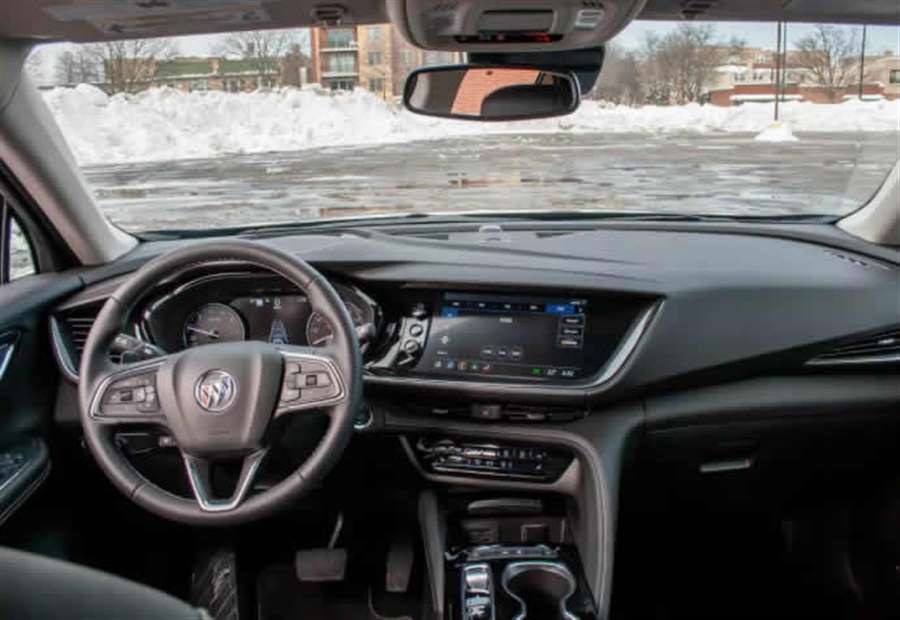
The Envision’s front bucket seats are comfortable, and they’re finished in cloth and simulated leather (Preferred) or perforated real leather (Essence and Avenir). The seats have modest side bolsters that don’t hold you in place when taking a corner quickly, however.
There’s surprisingly good rear-seat space for adult passengers. The bench seat is comfortable and there’s good headroom. The standard 60/40-split backrest folds flat with the cargo floor, extending the luggage area, but the seatback doesn’t recline.
Safety
Neither the Insurance Institute for Highway Safety nor the National Highway Traffic Safety Administration had crash-tested the 2021 Buick Envision as of publication. The list of standard active-safety features includes forward collision warning with automatic emergency braking, blind spot warning with rear cross-traffic alert, lane-keeping assist and automatic high-beam headlights. A head-up display, 360-degree camera system and adaptive cruise control are optional.
Value in Its Class
The Envision doesn’t fit neatly into the mainstream or luxury compact SUV classes, but to hear Buick tell it, that’s an opportunity. Rob Peterson, the brand’s marketing manager, said Buick serves shoppers moving up from mainstream brands and has both the Envision and the smaller and less expensive Encore GX to offer small SUV shoppers.
There are still some mainstream elements like cloth upholstery and manual air conditioning in base Envisions, but the mid-level Essence trim swaps them and more for upscale amenities without significantly ballooning the price tag. It’s a value recipe that seems right for the times.

